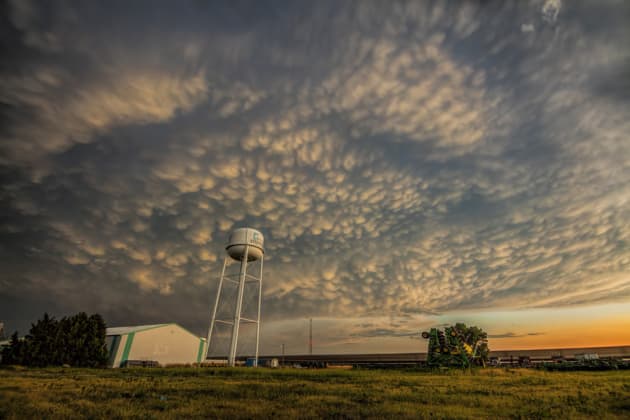Inside the tempest: Confessions of a storm chaser
When the weather’s terrible, it’s all too easy to stay indoors. AP’s Mike O’Connor meets a photographer who loves nothing more than getting out when the weather’s at its absolute worst.
The Hollywood movie Twister came out twenty years ago in May – and it remains probably the most well known film about wild weather. If you’re struggling to remember it, Bill Paxton and Helen Hunt play two storm-chasers who are forced to square off with a massive storm while trying to launch a prototype research device smack-bang into the middle of a category 5+ monster. I remember leaving the theatre thinking that storm chasing looked about as safe as walking into a lightning storm wearing a tinfoil hat. But award-winning weather photographer James Smart saw something totally different.
“Me and my brother saw Twister when we were kids, and thought it looked pretty cool,” he says, speaking to Australian Photography before heading off on his next storm-chasing trip to the US. “We decided to give it a go.”
For the past three storm seasons, James and his brother Rick have travelled to the U.S to join up with storm-chasing travel company Weather Adventures. And although photography and filmmaking run in the family, Smart never started out with any plans to be a photographer. “My brothers a cameraman, so it's definitely in the family,” says Smart. “But when we first travelled to the states, we were just joining the tours to see some big storms.”
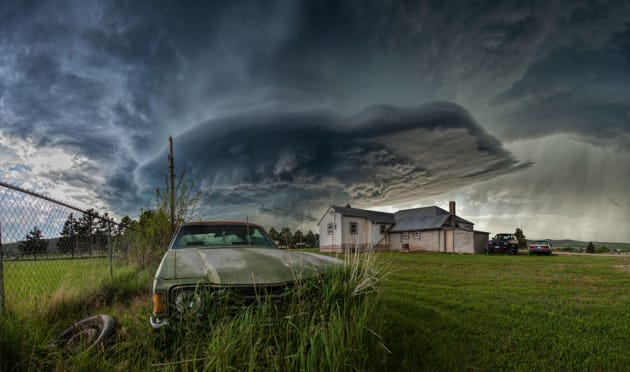
It was a trip to Europe when he was 26 that sowed the seed for pursuing photography as a career. “I was taking photos while travelling and when I came back to the Sunshine Coast, I was trying to narrow down what I wanted to do. I knew by then that photography was a passion, but I thought landscape photography would be the route I’d take. I like that landscapes are naturally lit so you don't need any additional lighting gear,” he says. Entirely self-taught, Smart says he watched his fair share of YouTube videos to figure it out for himself. “There was plenty of trial and error,” he admits, “looking back at some of my earlier photos it's a bit cringeworthy.”
But Smart’s talent for landscape photography was never in doubt, and he’s since spent the last few years splitting his time running a satellite dish for the TV show Sunrise, and photographing some of the East Coast’s most beautiful spots. But it was storms that had him hooked, and a trip in 2015 that brought his talents to a huge new audience.
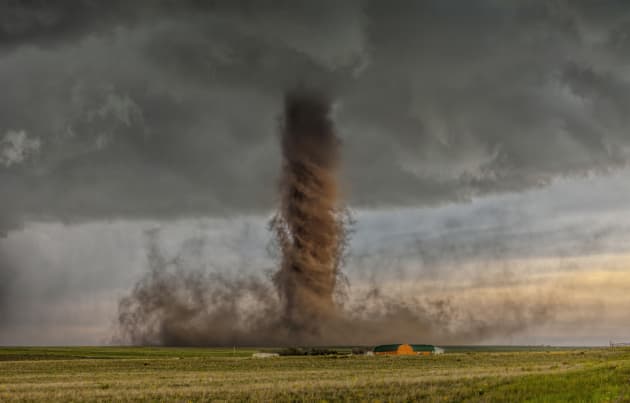
“We were driving back from Wyoming - we had a day to get to Dallas to fly home, and we thought we'd just take it easy and cruise home as it was an 18 hour drive. We stopped in Denver for something to eat, and thought we'd check the radar on the phone to see if anything was developing. I knew straight away it was something big.”
“We decided to chase the storm to see how it was going. An hour and a half later it put down it's first tornadoes, and then another one, and another one, and finally another one, there were two tornadoes on the ground, one north of us, one east of us, both at the same time – I’d never seen anything like it.
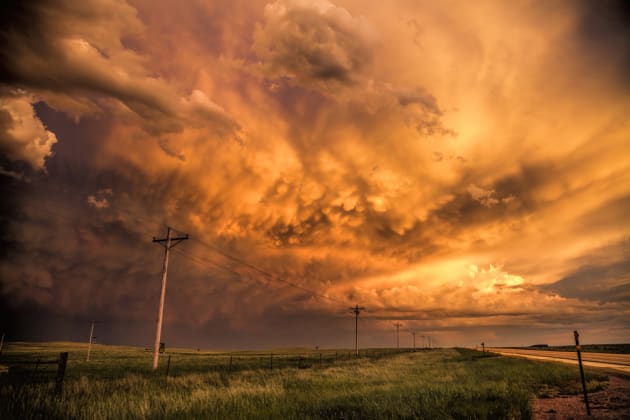
“Then the Northerly one started to rope out, but the one in the east was building, it eventually would turn into that photo, it just kept going for a couple of hours – I probably took about 6-700 photos as we followed it.”
That photo is Smart’s shot of an anti-cyclonic tornado near Simla in Colorado that quickly began drawing thousands of likes on the web, before finally winning him the National Geographic Photo of the Year for 2015. In doing so it also propelled his love for storm photography straight into the stratosphere.
Storm seeking
So what does it take to take photos of storms that will leave people slack-jawed? The best place to start says Smart, is a dedicated wild weather tour. “Tours are great as you meet likeminded people – you’ll sit down every morning and look at the forecast to get an idea of where you're going to go each day, you hop in a Chevy van, and then it's about getting out there,” he says. Tours will always have dedicated meteorologists on the team - meaning you have the best chance of choosing the right place to go for a sighting. And although having a working knowledge of weather systems is useful, it’s not vital believes Smart. “I’m still learning heaps about reading weather patterns,” he says.
In the U.S, the storm season starts in late April, and finishes by the start of July. It’s a narrow window with storms on most days, but it means it can also be pretty hectic when the seasons in full-swing. “It can be crazy, hordes of storm-chasers can cause traffic jams. If there's only one system going that day, people will pour into the area. You can now jump on apps that show you where storm-chasers are congregating,” he says. “People are always surprised when I tell them that fellow storm chasers can be the most dangerous part of it!”
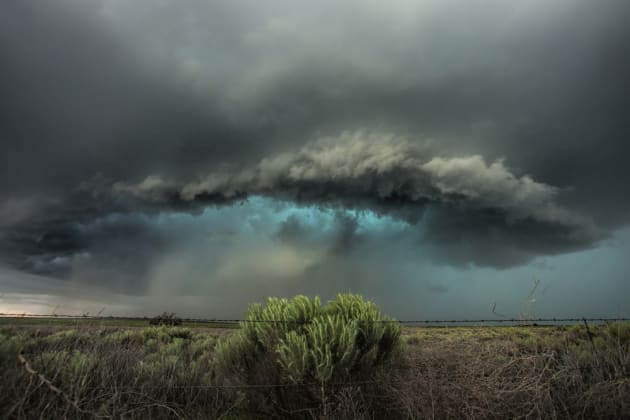
But that’s not say it isn’t without risks of it’s own. “Last season, we had two storms on the ground at once. You don't know where they are going to go or if you're going to get rain wrapped – that's when there's a tornado on the ground, and there's so much rain that it's wrapping around the thing, you can't see it or judge how far away it is. When the tornado is a mile and a half wide, it can be quite intense. You can't see a thing, and powerlines and stop signs are flying at a million miles an hour right past you,” explains Smart.
Smart reckons the best storm photos come from tornadoes, but you can’t always rely on them to form. “The best chance of a great photo is with what’s known as a supercell with the right ingredients,” he explains. A supercell is a thunderstorm that is characterised by the presence of a mesocyclone: a deep, persistently rotating updraft. They are responsible for nearly all of the significant tornadoes produced in the U.S. and for most hailstones larger than golf ball size. They also happen to look like something from outer space. “A ‘mothership’ formation which looks like it has just descended to earth is probably the ultimate.” says Smart.
Even if you can’t make it to the U.S, there are strong communities of storm-chasers in Australia. “Melbourne storm chasers, Queensland and NSW get all the action,” says Smart. But if you want a real twister experience, you just can’t beat the states. “Because the road networks are so good it makes chasing a lot easier. It's simply the best place in the world to be doing it,” he says.
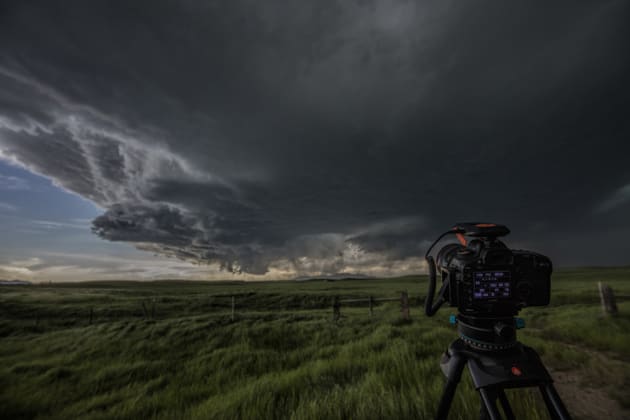
The gear
Because of the constant need to be on the move, a lightweight and versatile kit is probably the most important thing for successful storm photography. Smart’s camera of choice is the 50 megapixel monster Canon EOS 5DSR DSLR which he shoots on manual, but his lens choices are relatively simple, a 16-35mm wide and a 70-200mm zoom for that extra reach when you just can’t bring yourself to get that little bit closer. It’s also the lens he used to take the winning National Geographic photograph.
Although a tripod can be useful, often it’s not that practical. With time always of the essence, most of Smart’s photos are taken straight from the car window pulled over on the side of the road. “The majority of my shots are handheld as more often than not you don't have a lot of time to setup, but if we're shooting lightning we'll get the tripod up,” he explains.
Capturing lightning is the one area that always needs a tripod. “For lightning during the day, I have a trigger which will sense light and noise,” explains Smart. “ It’s really handy when trying to capture lightning when it’s light outside. You just set the speed of your shutter, something generally fast around 1/500 at least, then your aperture & ISO to what you desire and let the trigger do the rest. Using a filter like a 10 stopper, you can also attempt some long exposures during the daylight hours.”
“When it comes to lightning at night, long exposure is the way to go. It all depends on how far away the lightning is, and if it is heading towards your position, obviously you will have to change the settings quite regularly so the image doesn’t blow out,” he explains. “But if you shoot in RAW you can generally save some lightning shots by bringing down the highlights.”
Filters are also not usually necessary. “They can be great, but for chasing weather I generally don’t use any. The only exception would be if I was doing a time lapse so it has some cool looking movement with a 10 stopper on,” explains Smart.
Like most photographers, the Adobe Creative Suite is the go-to software for Smart’s photo development. “I use Photoshop CC & Lightroom for bulk editing,” he says. “Photoshop is such a great tool, especially with its ability with RAW images.” The only exception is panoramas. “If I shoot a panorama I will use PTgui to stitch them together, it does a great job and is relatively fast.”
When storm chasing you want your images out to be seen as soon as possible, because people love to see what has just happened in their area. “It’s always fun trying to edit in a moving vehicle straight from your lap as you race to the next location,” laughs Smart.
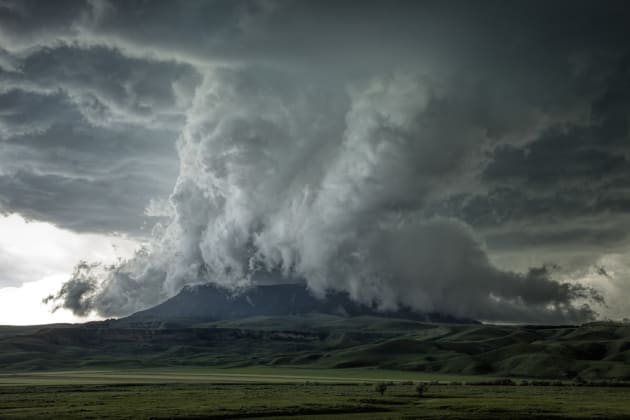
The art
Having the right gear and settings are only two parts of the puzzle. As Smart explains to me, strong composition is the most important thing and an absolute must when photographing something so massive. “I always look for something that can fill the foreground. This helps give it scale so the person looking at the image can see the size of a tornado or storm, compared to say a family home or a rundown car or similar. It also makes the image just that little bit more engaging, especially if it has some nice colour to it,” he says.
“I also really like to draw people to where you want them to look using something like leading lines,” he adds. “But that said you don’t always get the luxury of having those options. Sometimes the best photos just come from being in the right place at the right time.” ❂
